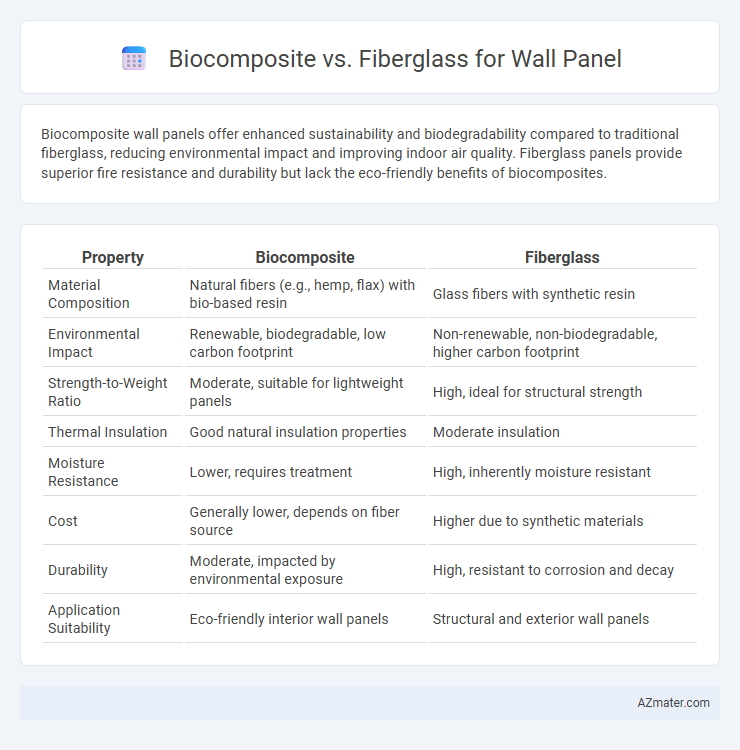Biocomposite wall panels offer enhanced sustainability and biodegradability compared to traditional fiberglass, reducing environmental impact and improving indoor air quality. Fiberglass panels provide superior fire resistance and durability but lack the eco-friendly benefits of biocomposites.
Table of Comparison
| Property | Biocomposite | Fiberglass |
|---|---|---|
| Material Composition | Natural fibers (e.g., hemp, flax) with bio-based resin | Glass fibers with synthetic resin |
| Environmental Impact | Renewable, biodegradable, low carbon footprint | Non-renewable, non-biodegradable, higher carbon footprint |
| Strength-to-Weight Ratio | Moderate, suitable for lightweight panels | High, ideal for structural strength |
| Thermal Insulation | Good natural insulation properties | Moderate insulation |
| Moisture Resistance | Lower, requires treatment | High, inherently moisture resistant |
| Cost | Generally lower, depends on fiber source | Higher due to synthetic materials |
| Durability | Moderate, impacted by environmental exposure | High, resistant to corrosion and decay |
| Application Suitability | Eco-friendly interior wall panels | Structural and exterior wall panels |
Introduction to Wall Panel Materials
Wall panel materials like biocomposites and fiberglass offer distinct benefits tailored to construction needs. Biocomposites combine natural fibers and polymers, providing eco-friendly, lightweight, and sustainable alternatives with enhanced thermal insulation properties. Fiberglass panels, composed of glass fibers embedded in resin, deliver superior strength, durability, and resistance to moisture and fire, making them ideal for high-performance wall applications.
Overview of Biocomposites
Biocomposites for wall panels combine natural fibers such as hemp, flax, or jute with a polymer matrix, offering a sustainable alternative to traditional fiberglass panels. These materials deliver enhanced insulation properties, biodegradability, and lower carbon footprint compared to fiberglass, which consists primarily of glass fibers and resin. Biocomposites also provide improved acoustic performance and reduced environmental impact, making them increasingly preferred in eco-friendly building applications.
Understanding Fiberglass Panels
Fiberglass panels consist of glass fibers embedded in a resin matrix, offering high tensile strength, moisture resistance, and durability, making them suitable for harsh environments and long-term use in wall panel applications. Their lightweight nature and ease of installation provide advantages over traditional materials, while their non-porous surface resists mold and mildew growth. Fiberglass's thermal insulation and fire-resistant properties contribute to energy efficiency and building safety in commercial and residential construction.
Comparative Strength and Durability
Biocomposite wall panels offer competitive strength by combining natural fibers such as hemp or flax with resin matrices, providing enhanced impact resistance and flexibility compared to traditional fiberglass panels. Fiberglass panels excel in durability with superior resistance to moisture, chemicals, and UV exposure, ensuring longevity in harsh environments. While biocomposites deliver eco-friendly benefits and reduced weight, fiberglass remains the preferred choice for applications demanding maximum structural integrity and prolonged lifespan.
Environmental Impact and Sustainability
Biocomposite wall panels, made from natural fibers like hemp or flax combined with bio-resins, offer a significantly lower carbon footprint and enhanced biodegradability compared to fiberglass panels, which rely on energy-intensive glass fiber production and synthetic resins. The renewable raw materials in biocomposites reduce dependency on fossil fuels and facilitate easier recycling or composting at end-of-life, whereas fiberglass often ends up in landfills due to limited recyclability. Sustainable sourcing and lower emissions during manufacturing position biocomposite panels as a greener alternative to conventional fiberglass for eco-conscious building projects.
Thermal and Acoustic Insulation Properties
Biocomposite wall panels offer superior thermal insulation due to their natural fiber composition, which reduces heat transfer more effectively than fiberglass. Acoustic insulation performance is enhanced in biocomposites as the fibrous organic materials absorb sound waves, minimizing noise penetration better than the denser fiberglass panels. With lower thermal conductivity and improved sound absorption coefficients, biocomposite panels provide eco-friendly, energy-efficient, and quieter wall solutions compared to conventional fiberglass.
Installation and Workability
Biocomposite wall panels offer easier installation due to their lighter weight and flexibility compared to fiberglass, which often requires specialized handling and cutting tools. The workability of biocomposites allows for faster customization on-site, reducing labor costs and time, while fiberglass panels can be brittle and prone to cracking during modification. Both materials require proper safety measures, but biocomposites generally pose fewer hazards linked to fiber inhalation and dust generation.
Cost Comparison
Biocomposite wall panels typically cost 20-30% less than fiberglass panels due to lower raw material and manufacturing expenses. Fiberglass panels require energy-intensive production and specialized handling, increasing overall installation and maintenance costs. Long-term savings with biocomposites also stem from their biodegradability and reduced disposal fees compared to non-recyclable fiberglass waste.
Maintenance and Longevity
Biocomposite wall panels offer superior resistance to moisture, mold, and UV damage, reducing maintenance needs compared to fiberglass panels that can degrade or require regular sealing over time. The natural fibers in biocomposites enhance durability and thermal stability, extending the lifespan of wall panels under varying environmental conditions. Fiberglass panels may suffer from brittleness and discoloration after prolonged exposure, limiting their longevity relative to the eco-friendly, resilient biocomposite alternatives.
Future Trends in Wall Panel Technologies
Biocomposite wall panels are gaining traction due to their sustainable materials, lower carbon footprint, and improved thermal insulation compared to traditional fiberglass panels. Innovations in biocomposite formulations enhance durability and moisture resistance, positioning them as a viable alternative in green building initiatives. Emerging trends indicate a shift towards hybrid panels combining biocomposites and fiberglass for optimized performance in strength, fire resistance, and environmental impact.

Infographic: Biocomposite vs Fiberglass for Wall panel
 azmater.com
azmater.com